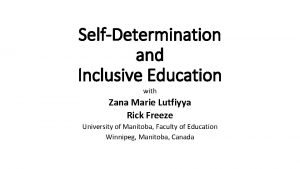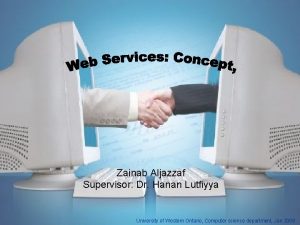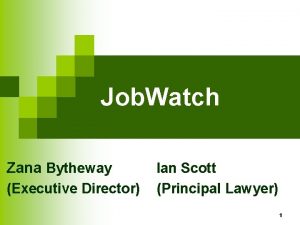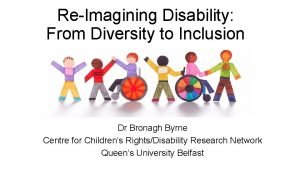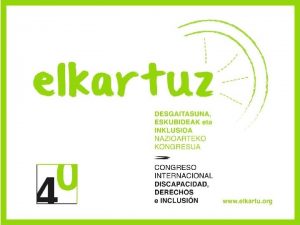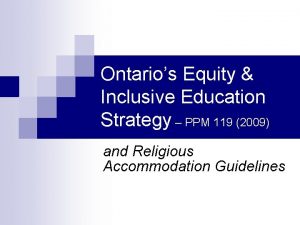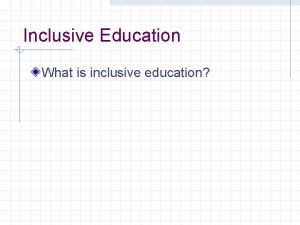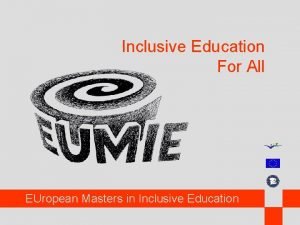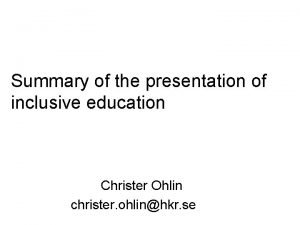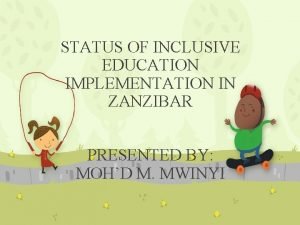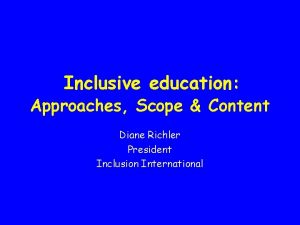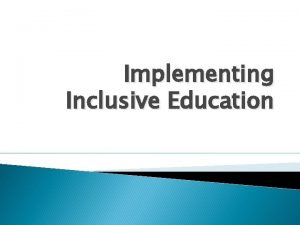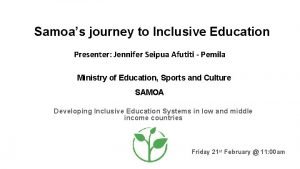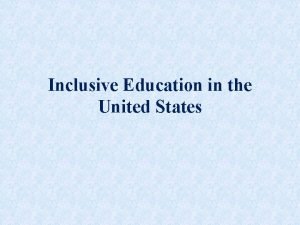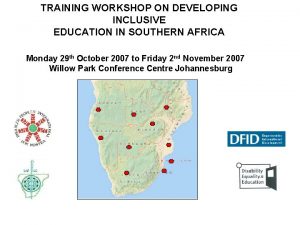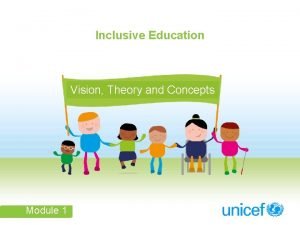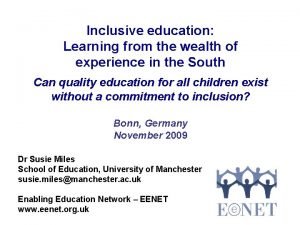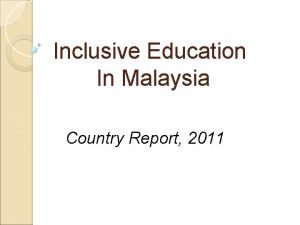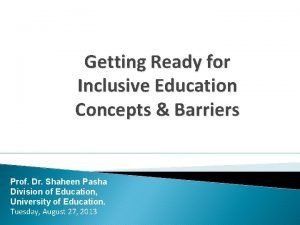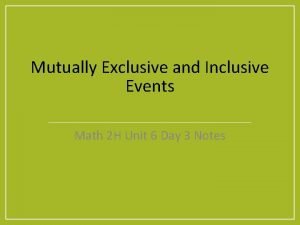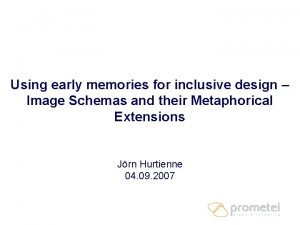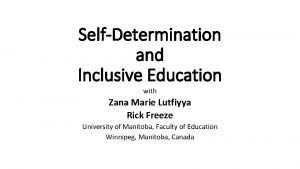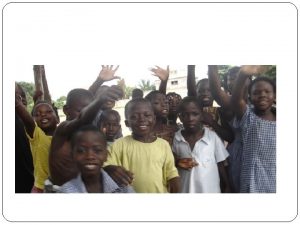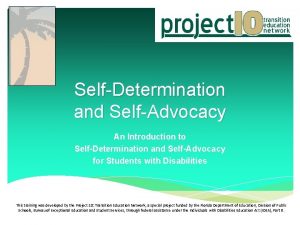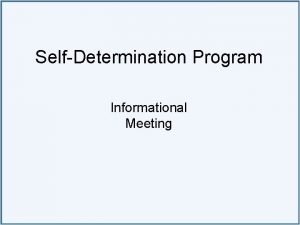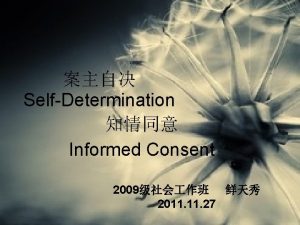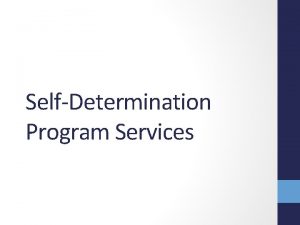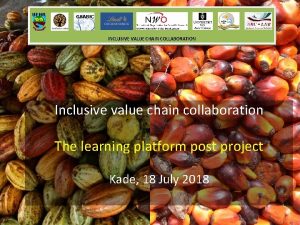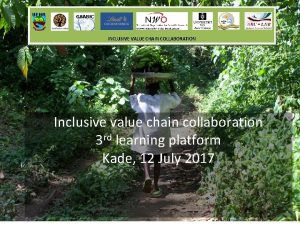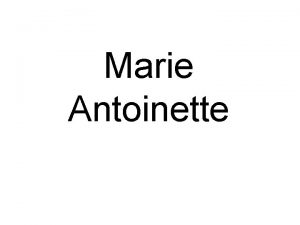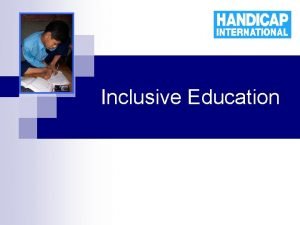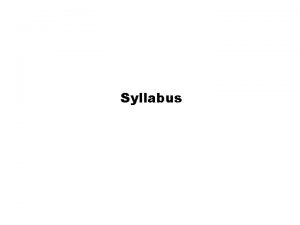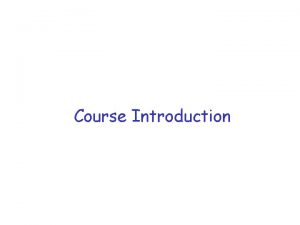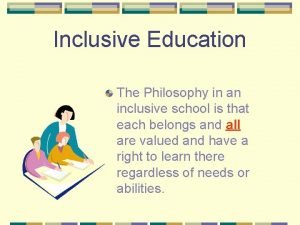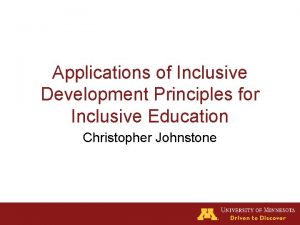SelfDetermination and Inclusive Education with Zana Marie Lutfiyya


























- Slides: 26

Self-Determination and Inclusive Education with Zana Marie Lutfiyya Rick Freeze University of Manitoba, Faculty of Education Winnipeg, Manitoba, Canada

Conceptualizations of Self-Determination Seen as: • empowerment • motivation • learned behavior • self-advocacy Rationale: leads to “quality of life”

Self-Determination as Empowerment Circumstances and actions that enhance the possibilities for people to control their lives.

Self-Determination as Motivation An innate propensity to engage in personal interests, exercise personal capacities and overcome personal challenges.

Self-Determination as Learned Behaviour Lifelong learning, opportunities, and experiences that result in an individual becoming the primary causal agent in his or her own life.

Self-Determination as Learned Behaviour Involves: • autonomy • self-regulation • internal locus of control • self-knowledge

Self-Determination as Learned Behaviour Autonomy: • from Greek “autos” (self) + “nomos” (rule) • making choices and decisions • free from undue external influence or interference • not the same as “independence” – some may depend on technology or other people to achieve autonomous self-determined outcomes

Self-Determination as Learned Behaviour Self-regulation: • awareness of environmental opportunities and constraints • self-awareness of personal possibilities and limitations within environments • ability to make decisions about how to act Continued next slide

Self-Determination as Learned Behaviour Self-regulation: • ability to evaluate outcomes of personal actions • ability to revise decisions as necessary • not the same as “agency” - some may depend on technology or other people to achieve selfregulated outcomes

Self-Determination as Learned Behaviour Internal locus of control: • control over important personal circumstances • self-efficacy – possession of requisite skills to achieve desired outcomes • outcome expectation – reasonable belief that desired outcomes will be achieved if requisite skills are applied • not the same as “self-sufficiency” - some may depend on technology or other people to exercise control

Self-Determination as Learned Behaviour Self-knowledge of: • personal strengths and limitations • how personal strengths can be supported and enhanced (i. e. , learning scaffolds, technologies, peer and personnel supports, institutional services, etc. ) • how to select or modify environmental circumstances that effect personal learning

Self-Determination as Learned Behaviour Self-knowledge of: • how personal limitations can be mitigated • how to appeal inadequate provisions • how to access and use institutional and social supports for advocacy and inclusion

Self-Determination leads to Quality of Life Quality of life is: • composed of the same factors and relationships that are important to persons without disabilities • experienced when a person's (or his or her family's or community's) basic needs are met • when a person has the same opportunities as anyone else to pursue and achieve goals in the major life settings of home, community and work

Self-Determination leads to Quality of Life Quality of life is: • grounded in the person’s and family’s strengths • variable over each person's lifespan • congruent with public values and behavior • validated by others representing a variety of viewpoints, including: the person’s family, and the professionals, service providers, and disability advocates involved in his or her life

Limits to Self-Determination Age: • formal restrictions in law (e. g. , voting, entering a contract, driving a car, etc. ) – same as for nondisabled, multiple restrictions may apply • informal restrictions in custom (e. g. , prejudice and discrimination, environmental barriers, etc. ) – may be same as for non-disabled or unique to disabled, multiple restrictions may apply

Limits to Self-Determination Experience: • lack of knowledge of implications of decisions • lack of knowledge of alternative options • lack of capacity to do something • lack of developmental experiences to build capacity • low expectations grounded in gender, disability, racial or other forms of discrimination

Limits to Self-Determination Experience: • lack of inclusive technology • lack of inclusive environments • lack of inclusive policies • lack of inclusive teaching • lack scaffolded or supported learning

Limits to Self-Determination Impairments: • lack of ability to be aware of opportunities for self-determination • lack of ability to be aware of supports for selfdetermination • lack of ability to communicate decisions

Limits to Self-Determination Impairments: • may vary over time • may require good faith advocates and intervenors • some individuals may need protection from exclusion, indifference and exploitation

Limits to Self-Determination Poor Judgement: • inability to make wise decisions due to lack of self -awareness • inability to make wise decisions due to misunderstanding his or her circumstances • lack of knowledge of available learning scaffolds, technologies and peer and personnel supports

Practical Implications Create opportunities for developmentally appropriate: • control of personal environments • engagement in personal interests • exercise of personal capacities and strengths • opportunities to face, struggle and ultimately overcome personal challenges

Practical Implications Create opportunities for developmentally appropriate: • choice-making • decision-making • problem-solving • goal setting and attainment

Practical Implications Teach: • self-observation, self-evaluation, and selfreinforcement • positive attributions of efficacy and outcome expectancy • awareness of environmental opportunities and constraints • self-awareness of personal possibilities and limitations within environments

Practical Implications Teach: • how personal strengths can be supported and enhanced (i. e. , learning scaffolds, technologies, peer and personnel supports, institutional services, etc. ) • how to select or modify environmental circumstances that effect personal learning

Practical Implications Teach: • self-advocacy skills • how personal limitations can be mitigated • how to appeal inadequate provisions • how to access and use institutional and social supports for advocacy and inclusion

Practical Implications Provide: • inclusive technology (based on Universal Design for Learning principles) • inclusive (barrier free) environments • inclusive policies (eliminate segregation, promote valued social roles) • inclusive teaching through scaffolded learning (Differentiated Instruction) • good faith advocates and intervenors
 Zana marie
Zana marie Hanan lutfiyya
Hanan lutfiyya Zana bytheway
Zana bytheway Liceum zana
Liceum zana Reimigining disability and inclusive education
Reimigining disability and inclusive education Reimigining disability and inclusive education
Reimigining disability and inclusive education Ontario's equity and inclusive education strategy
Ontario's equity and inclusive education strategy Inclusive education and community partnership
Inclusive education and community partnership Aims and objectives of inclusive education
Aims and objectives of inclusive education Jämförlighet
Jämförlighet Inclusive education
Inclusive education Inclusive
Inclusive Diane richler
Diane richler Unesco inclusive education
Unesco inclusive education Inclusive education policy
Inclusive education policy What is this photo
What is this photo Objectives of inclusive education
Objectives of inclusive education Conclusion of national policy on education 1986
Conclusion of national policy on education 1986 Objectives of inclusive education
Objectives of inclusive education Inclusive education definition
Inclusive education definition Disadvantages of inclusive education slideshare
Disadvantages of inclusive education slideshare Acrostic poem about inclusive education
Acrostic poem about inclusive education Barriers to inclusive education
Barriers to inclusive education Mutually exclusive vs mutually inclusive
Mutually exclusive vs mutually inclusive Inclusive events examples
Inclusive events examples Addition rule
Addition rule Inclusive schema
Inclusive schema
